How many times have you waited, filled with hope, for a new product to be delivered, only to be disappointed when it arrives and makes no difference to your skin?
In a market full of products with false or exaggerated claims, it’s difficult to know what works. Sure, it’s dermatologically tested and non-comedogenic, but can it really help fight acne?
Maybe you feel like you’ve got no good way to compare products, and don’t want to fall victim to another over-hyped cream, gel or lotion that proves useless for your breakouts.
Here’s the truth. Ingredients make or break a skincare product. To be able to choose the right products for your skin, you need to understand how their ingredients work. The good news is that once you do, you can start to combine multiple ingredients for maximum effect.
That’s precisely why I created this guide. To help you make sense of your products and know what you should be looking for. By the end of this article, you’ll also be armed with the best ingredient combinations, helpful in fighting multiple causes of acne.
Before breaking down the ingredients themselves, let’s start by examining exactly how topical products help reduce acne.
5 ways skincare ingredients can reduce acne
In topical acne treatment, there are five possible mechanisms of action. In other words, there are five different properties that skin care products can have, to help treat your breakouts.
Each of these beneficial properties tackles a different aspect of the acne-formation process and every acne-fighting topical relies on one (or more) of these actions to improve your skin. Let’s take a look at each:
1. Antibacterial
Bacteria living on the skin (particularly P. Acnes) contribute to the appearance of acne. These bacteria develop in blocked pores, causing local irritation.
This irritation increases inflammation in the area and turns a harmless blocked pore, into an angry pimple. Antibacterial agents in skincare products help kill these bacteria before they can irritate and inflame your skin.
2. Antioxidant
Oxidative damage to the skin’s sebum is the trigger that kicks off the acne formation process. Antioxidants are the agents that counteract the effects of highly reactive and harmful chemicals called reactive oxygen species (ROS).
This way antioxidants protect your sebum from UV radiation, air pollution and other forms of oxidative damage, and thus help to reduce acne formation.
3. Anti-inflammatory
Cells have an ‘alarm button’ that they press when they’re exposed to bacteria or get damaged. This calls the immune system into high alert and inflammatory chemicals are sent to the affected site.
For those with acne, this means pimples become red, swollen and painful. Anti-inflammatory substances either deactivate the alarm or reduce the intensity of the inflammatory response, by suppressing immune function.
4. Keratolytic
Our skin contains a number of proteins, collectively known as keratin. Normally, keratin protects the skin from external damage. But an excess of keratin prevents dead skin cells from separating.
When this happens sebum cannot flow properly and pores become blocked. Keratolytic substances combat this in two ways. They either reduce keratin production (e.g. retinoids), or dissolve excessive keratin (e.g. salicylic acid).
5. Reduced sebum production
The more sebum the skin produces, the more sensitive it is to oxidative damage, and the more likely it is that pores get blocked. Some topical ingredients (such as green tea extract) reduce sebum. Thus limiting oxidative damage and indirectly reducing pore blockages.
A combined effect
Acne results from a combination of complex mechanisms. As such, your anti-acne skincare regimen should include ingredients with properties that target as many of these as possible. As a rule of thumb, the more of these properties you can stack in your regimen, the more effective it is likely to be.
Unfortunately, no single ingredient boasts all 5 of the beneficial properties. But by combining ingredients, it’s usually possible to hit most, if not all, of the properties. This is made easier by the fact that many single ingredients have at least 2 modes of action.
Let’s start by exploring two traditional ingredients, used in many over-the-counter products. We’ll then consider several naturally occurring ingredients that can also be effective in combating acne-formation.
Traditional acne fighters
Benzoyl peroxide and salicylic acid are the two most popular, topical acne treatments. Both have been used for years and are available over-the-counter, without a prescription. Let’s take a closer look at both, in turn.
Benzoyl peroxide (BP)
This popular ingredient is an antibacterial. BP is effective in preventing the growth of acne-causing bacteria (P. Acnes) on the skin. It is fat soluble, which allows it to pass into the skin’s pores. Within the pores, it rapidly dissolves into benzoic acid and hydrogen peroxide. Thus generating free radicals that kill bacteria and yeast living in the skin.
BP also has an anti-inflammatory effect, as it is toxic to white blood cells. In the skin, white blood cells act as alarm signals. When they detect a danger (like the presence of P. Acnes bacteria) they raise an ‘alarm’, which alerts the immune system to the area.
This immune reaction is what causes the inflammation in acne. So, while BP itself does not have anti-inflammatory properties, it can prevent an inflammatory response by destroying white blood cells.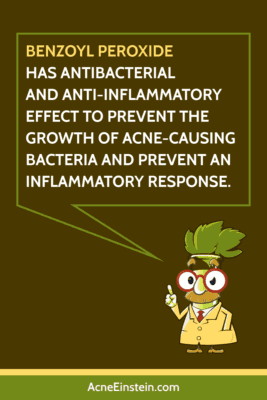
How effective is BP?
A Japanese study tracked 393 people over 12 months, to see how well BP gels reduced acne. The doctors counted the number of pimples each participant had at the start of the study, and every 4 weeks for a year. The graph below shows the average number of pimples through the study period.
On average, the number of pimples was reduced by 75% at week 24. Other studies have shown BP as a sole treatment is roughly as effective as topical antibiotics or retinoids.
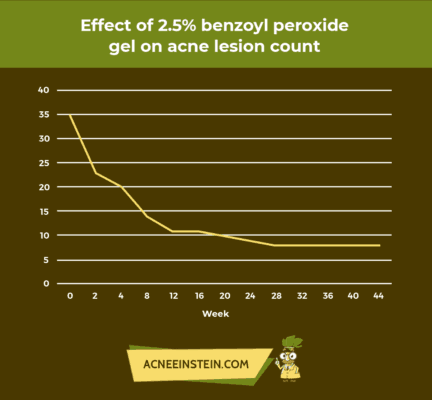
Suggested concentration?
2.5% BP is enough, daily. In the Japanese study above, the two groups used either 2.5% or 5% BP. They found no difference in either inflammatory or non-inflammatory acne. In fact, the only difference they noted was in terms of side effects. 5% BP was determined more irritating, without any added benefits.
Salicylic acid (SA)
Salicylic acid is a keratolytic agent found in many retail store acne formulations. SA is oil-soluble, meaning it is able to deeply penetrate pores and increase skin cell turnover (i.e. help with skin shedding). It is the most common beta-hydroxy acid and on product labels it is often referred to as BHA. SA also has a mild anti-inflammatory effect.
How effective is SA?
Unfortunately, most studies on SA as a sole acne treatment have used 30-70% SA chemical peels. While these chemical peels reduce acne, this is not something you can usually do at home. These peels should be done either at a doctor’s office or by an esthetician.
In studies that combined SA with antioxidants, results do seem promising. For example, a study found that an SA and antioxidant cream blend, reduced inflammatory pimples by 61% and non-inflammatory pimples by 74%. However, it is difficult to know how much of this reduction can be credited to SA.
Suggested concentration?
The FDA only permits SA in concentrations of 0.5-2%. As such, you may find topical SA to be less effective than in the above studies. For this reason, as long as SA is tolerated well by your skin, the maximum concentration of 2% is recommended. You may wish to switch to a lower concentration if you experience discomfort, burning, irritation or redness.
Benzoyl peroxide vs. salicylic acid: which should you use?
Most dermatologists consider SA to be less effective than BP. However, the lack of direct-comparison studies makes it hard to draw firm conclusions.
SA is typically used in combination with other products, by people who cannot tolerate the common skin irritation associated with BP, or prescription retinoids. You may find the comparative table below helpful in choosing between BP and SA:
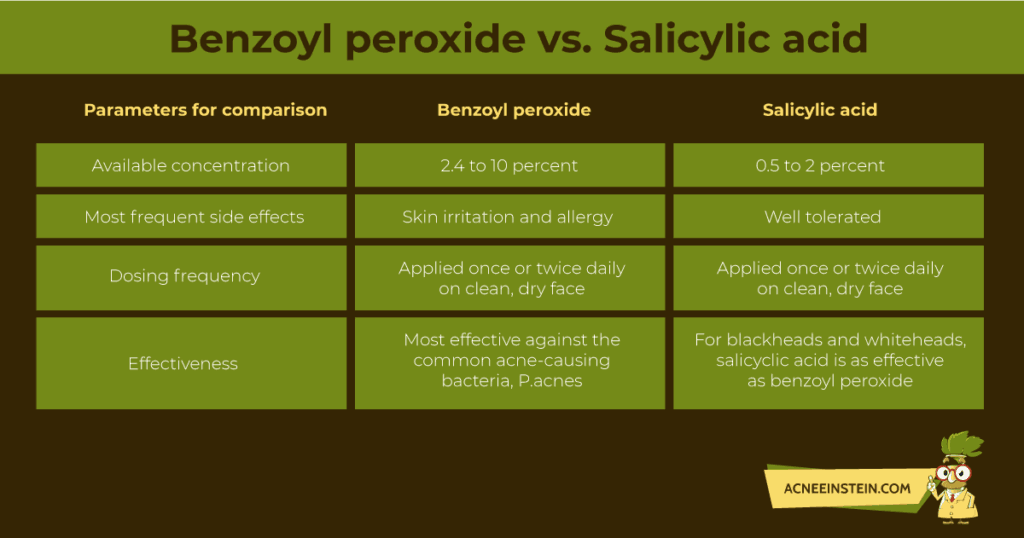
Overall, SA is not recommended as a sole treatment for acne. But when combined with natural antioxidants, SA can help form part of a powerful team.
Let’s now take a look at natural acne-fighting options, that can supplement traditional topicals or be used instead of them.
Natural ingredients
Many vitamins, herbs and plant products have been found to be effective against acne.
Vitamin C
Vitamin C is a powerful antioxidant, capable of protecting sebum (and the skin) against oxidative damage. Vitamin C reduces oxidative stress on the skin, protecting it from the harmful effects of UV radiation. Although it’s insufficient as a sunscreen replacement.
Vitamin C also has both anti-inflammatory and antibacterial properties. Plus, it boosts collagen production, helping skin appear wrinkle-free. Besides fighting active acne, Vitamin C can also treat hyperpigmentation – the dark spots and acne scars which remain following breakouts.
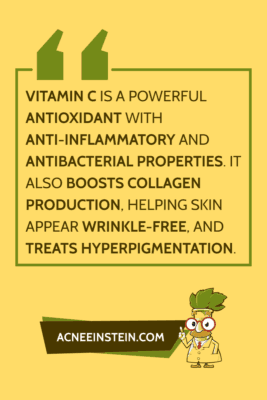
How effective is vitamin C?
There is research that suggests Vitamin C is comparable to retinol when it comes to fighting acne. For example, a study in the International Journal of Cosmetic Science compared the effectiveness of 5% vitamin C with 0.2% retinol, or a combination of both. After 8 weeks, acne was reduced by 48% in the vitamin C group, by 50% in the retinol group, and by 63% in the combination group.
Another study compared a vitamin C lotion to BP. 77% of the people treated with the vitamin C lotion showed ‘good to excellent’ results, compared to 61% in the BP group.
Suggested concentration?
Concentration depends on which form of Vitamin C you use. Ascorbic Acid (AA) is the natural and most effective form of vitamin C. However, it’s highly unstable and using AA in skincare products risks them going bad.
AA is also the form of Vitamin C most likely to cause skin irritation. As such, manufacturers have turned to alternate, more stable forms such as Sodium Ascorbyl Phosphate (SAP) and Magnesium Ascorbyl Phosphate (MAP), among others.
The negative here is that these other forms are less effective, as they have to be converted into the active form (AA) first. But in general, 5% SAP/MAP is effective – just make sure to check which form is used.
Vitamin B3
Vitamin B3 , also called niacinamide, is another anti-acne powerhouse. It is a potent anti-inflammatory agent and also acts as an antibacterial.
Although it does not directly kill bacteria, it enhances the skin’s own natural antibacterial mechanism by boosting the production of antimicrobial peptides (AMP). Vitamin B3 also has a weak inhibitory effect on sebum production.
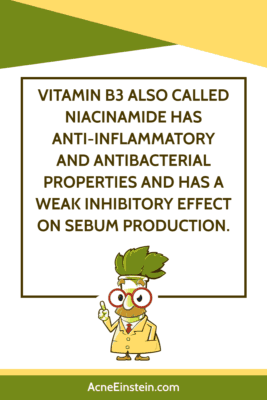
How effective is vitamin B3?
Several studies have compared topical B3 to topical antibiotics. In all of the studies, the B3 lotion was either as or more effective than the antibiotic formulations. Here are the results of one of the studies.

Suggested concentration?
In the aforementioned studies, a concentration of 4% was shown to be effective.
Green tea
Green tea is currently most popular in Asian skincare brands, but is slowly increasing in worldwide popularity. It is a versatile acne fighter, with antioxidant, anti-inflammatory and antibacterial properties. Green tea can also reduce sebum production.

How effective is green tea?
In 2013, Korean researchers tested 1% and 5% EGCG (EGCG is a green tea catechin – antioxidant) creams on acne patients. Below is a graph from the study’s results. Graphs C and D show the development on non-inflammatory and inflammatory lesions.

Another study tested two different topical green tea formulations (using 2.5% and 5% extracts). Both lotions caused about a 30% reduction in sebum production as compared to a placebo.
Suggested concentration?
Look for something with 2% or more green tea extract.
Retinol
Retinol (or vitamin A1) is a common anti-acne ingredient in non-prescription skincare products. It reduces acne by shedding dead skin cells and clearing clogged pores – it has a keratolytic effect. Retinol also acts as an antioxidant.
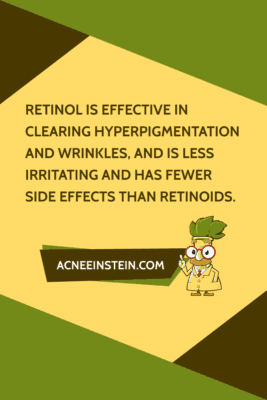
Don’t confuse retinol with retinoids orretinoic acid. Retinol is a milder form of vitamin A that has anti-acne properties. Conversely, retinoids refer to a group of chemicals derived from vitamin A or that are chemically similar to vitamin A.
Topical retinoids are stronger and only available with a doctor’s prescription. Tretinoin for example, is a prescription retinoic acid. Retinol is converted to retinoic acid, but this conversion is fairly weak. For that reason, retinol is less effective than prescription retinoids.
How effective is retinol?
Only one study has looked at whether retinol reduces acne. The study compared the effectiveness of 5% SAP (the form of vitamin C), 0.2% retinol, or their combination. The below graph shows the average reduction in inflammatory acne (in number of pimples) for each group in weeks 4 and 8. Both retinol and vitamin C lotions effectively reduced acne by almost 50% after 8 weeks.

Beyond the treatment of active acne, retinol is also quite effective (and often used) in reducing hyperpigmentation and wrinkles.
For example, in one study, the use of a retinol moisturizer showed around a 50% better improvement (compared to a standard moisturizer) in hyperpigmentation, wrinkles, fine lines, and overall photodamage.
Overall, while less effective than retinoids in treating acne, retinol is still a useful treatment option. Retinol is effective in clearing hyperpigmentation and compared to retinoids, it is less irritating and has fewer side effects.
Suggested concentration?
Studies suggest a concentration 0.2% or more is effective in treating mild acne.
Tea tree oil
This age-old natural anti-acne ingredient is a powerful antibacterial and anti-inflammatory.
How effective is tea tree oil?
A wealth of studies support the beneficial role of tea tree oil in acne. Indeed, one study that compared 5% tea tree oil to 5% benzoyl peroxide gel found that both had comparable effectiveness.
In another study, researchers compared tea tree oil to a popular prescription topical antibiotic. Surprisingly, participants using tea tree oil achieved a 55% reduction in pimples while the antibiotic group saw only a 40% reduction.
Overall, tea tree oil appears capable of treating acne to a degree comparable to traditional alternatives.
Suggested concentration?
As in the study above, a 5% concentration of tea tree oil has been shown to be effective.
Azelaic acid
Azelaic acid is a multipurpose, natural option for the skin with keratolytic, antibacterial, and antioxidant properties. Primarily, it works as a keratolytic agent and helps to separate dead skin cells and prevents pores from getting blocked.
How effective is azelaic acid?
A study tested 15% azelaic acid foam (Finacea Foam) on people with body acne. 18 people used the foam for 16 weeks. This graph shows the results.
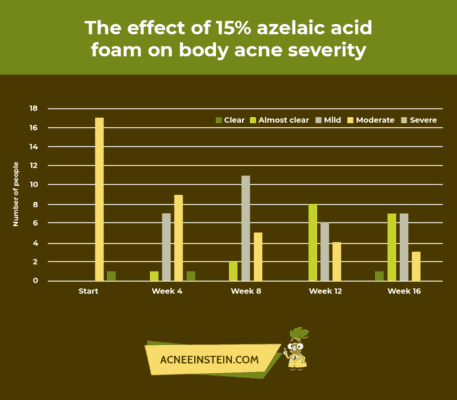
Another study found that for patients with mild‐to‐moderate acne vulgaris, a 20% azelaic acid cream reduced total lesion count by 53.9%, over 12 weeks. A 15% gel azelaic acid gel has also been shown as a safe and effective treatment for female adult acne.
Additionally, azelaic acid has proved effective in fading scars and dark spots.
Suggested concentration?
While there’s no doubt that azelaic acid is effective against acne, this effect appears to require at least a 15-20% concentration. In these concentrations, azelaic acid is prescription only.
Unfortunately, that means over-the-counter azelaic acid products are unlikely to be worthwhile.
Alpha hydroxy acids
The term alpha hydroxy acids (AHAs) refers to a group of naturally occurring acidic substances. The following substances are all examples of an AHA:
- citric acid (found in citrus fruits)
- glycolic acid (found in sugarcane) – most popular in skincare
- lactic acid (found in sour milk)
- malic acid (found in apples)
- tartaric acid (found in grapes)
When applied to the skin, AHAs inhibit the growth of acne-causing bacteria and remove dead skin cells via a keratolytic effect. AHAs also have a (relatively weak) antibacterial action.
While AHA acids peel the skin, helping to keep pores open, they are water soluble. Water-soluble substances cannot penetrate the skin. So fat-soluble substances, like salicylic acid, are typically more effective at unclogging pores.
Positively though, applying AHAs on the skin reduces skin pH. A low pH inhibits microbial growth and prevents acne bacteria from taking over the skin.
How effective are AHAs?
In one study, 120 patients with mild acne were asked to apply 10% glycolic acid (GA) or a placebo, once a day, for 90 days. At the end of the study period, researchers found the 10% GA indeed reduced acne (see graph below).

Nonetheless, the difference between the GA group and placebo group was relatively small. This suggests GA can reduce acne slightly, but that it’s not a very effective treatment by itself.
For this reason, AHAs can be a part of an effective skincare regimen, but are not recommended as the the sole treatment for acne.
Suggested concentration?
10% or higher when used as sole treatment.
Combining anti-acne ingredients
Let’s recap what we know so far.
There are 5 different mechanisms by which anti-acne ingredients work
- antibacterial
- antioxidant
- anti-inflammatory
- keratolytic
- reduction in sebum
As every single ingredient lacks all 5, you should consider using a product that combines ingredients with different properties. You may also consider using multiple products, if tolerated by your skin.
See the effect matrix table given below and mix and match a combination that works for you.
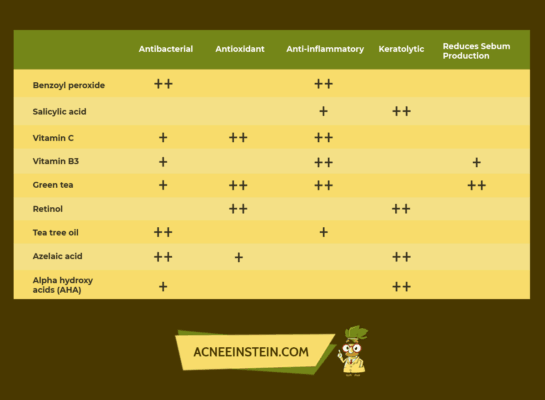
What do I recommend?
Each of the below combinations contain a total of either 4 or 5 properties, providing a broad spectrum of protection against acne. These combinations would be a good place to start:
- Salicylic acid + tea tree oil + vitamin C
- Retinol + tea tree oil + green tea
- Benzoyl peroxide + AHA + green tea
- Salicylic acid + vitamin B3
Finding the right products
You’ve made it through the anti-acne ingredients guide! You should now have a good understanding of the working mechanisms behind anti-fighting ingredients, which are the most effective and the best ways to combine them.
Remember that it’s important to patch test each product first and watch out for potentially irritating ingredients. Also, once you’ve decided on a product, make sure to use it consistently for at least 4-6 weeks before making any conclusions about how effective it is.
While working out the best topical combinations for your skin, you may also benefit from taking this 5-minute quiz to identify your acne type – understand why you get acne and learn what you can do to get over it!

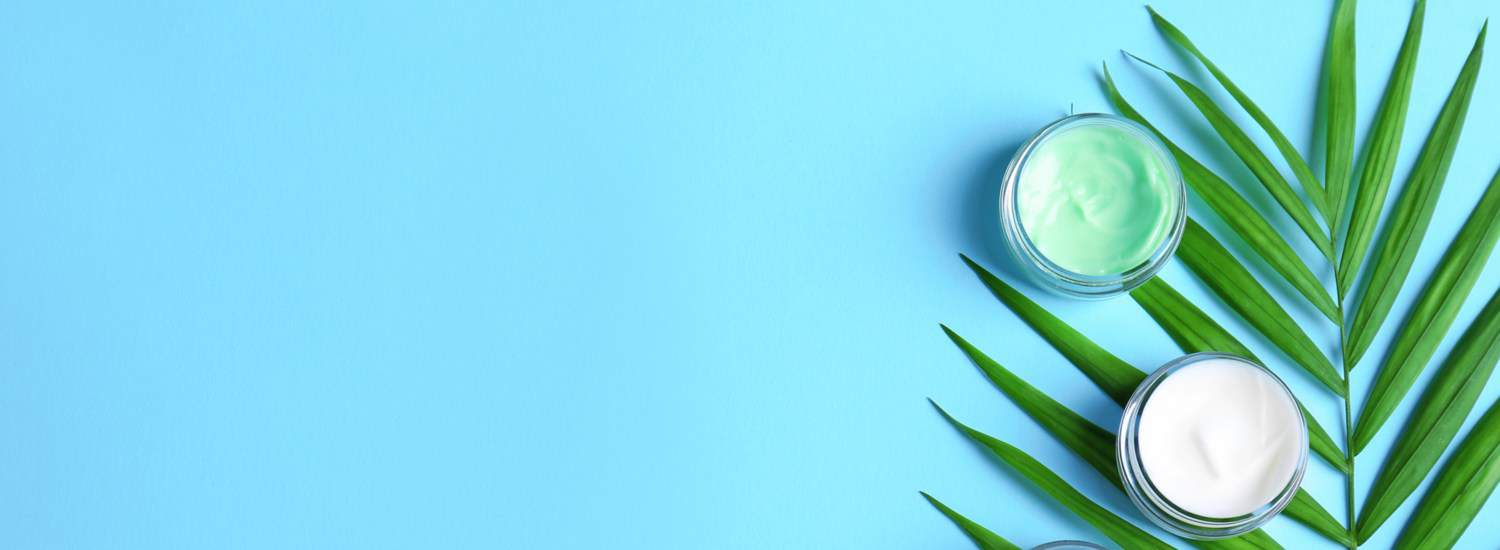
Thank you for this very interesting article ! I have three questions ;
1) I am quite astonished, because I had alway heard that Benzoyl Peroxyde was a keratolytic ? Why don’t you mention that in your matrix ?
2) Also, is it a good idea to use Benzoyl Peroxyde only very locally, to treat inflammatory pimples when I have some ? Will it be useful ? It seems that inflammatory pimples need both anti-inflammatory and anti-bacterial properties to be cured …
3) How do you measure the anti-oxydant properties of the ingredients ? For example, why has azelaic acid only one “+” when green tea has two ?
thank you very much !